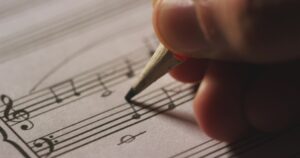Developing a good sense of rhythm is one of the most challenging parts of being an in-home piano teacher. It’s not something that arrives overnight, and it’s something that must be maintained as the student advances to music with more advanced rhythms and time signatures.

It truly is something that must be developed. I’d like to suggest that there are three components to having and developing what we so loosely refer to as a “good sense of rhythm”:
1. A Sense of Beat
This means the ability to maintain a steady beat/pulse. This is probably the most common and most basic problem that students encounter when it comes to rhythm issues in their piece. The inability to maintain a steady beat/pulse is crucial for developing numbers two and three below.
2. A Sense of Rhythm (Note Values)
This involves being able to accurately identify and execute the various note values within a variety of tempi. Beginner students may struggle with placing eighth notes within a quarter note beat, while more advanced students may struggle with syncopated rhythms or playing 2 against 3. It is nearly impossible to develop a sense of rhythm without first developing a sense of beat.
3. A Sense of Meter
 This may very well be the most elusive component of the three. At the most basic level, issues with proper sense of meter will evidence themselves when, for example, a student fails to maintain 3/4 time by extending the third beat so that they are actually in 4/4 time (a common issue among beginners). At more advanced levels, issues with proper sense of meter will evidence themselves when, for example, a student feels cut time (2/2) as common time (4/4), or feels 4/4 or 3/4 time as more like 1/4 (not uncommon in Bach’s contrapuntal pieces). Losing sight of the meter is like failing to see (or feel) the big picture.
This may very well be the most elusive component of the three. At the most basic level, issues with proper sense of meter will evidence themselves when, for example, a student fails to maintain 3/4 time by extending the third beat so that they are actually in 4/4 time (a common issue among beginners). At more advanced levels, issues with proper sense of meter will evidence themselves when, for example, a student feels cut time (2/2) as common time (4/4), or feels 4/4 or 3/4 time as more like 1/4 (not uncommon in Bach’s contrapuntal pieces). Losing sight of the meter is like failing to see (or feel) the big picture.
An Essential Musical Component
Consider offering a sort of “Rhythm Class” for your students. This will allow them a chance at musical development alongside their other lesson requirements, plus it shows them just how important it is for a musician to have good rhythm. Developing a sense of beat (#1 above) can be done with activities involving tapping, clapping, or walking the beat while singing and moving. Soon after, students can begin echoing and creating various rhythms within the steady tempo to begin absorbing how note values (#2 above) work. And of course, the in-home teacher will present these rhythm activities within certain meters/time signatures (#3). Although the students may not yet be at the point where they can understand what a time signature means, they can at least begin absorbing and feeling what these meters sound and feel like. All these things are great foundations for future lessons.
Rhythm-a-Ning
When a student has a rhythmic issue in one of their pieces, it can be really beneficial to further identify which of the three components above may be lacking and causing the issue in this case. An issue in understanding what a half note means is quite different from an issue with keeping a steady beat, for example! For practice I would suggest rhythm games and flashcards. Even if they are not able to practice at a piano, have the student or parent try a smart phone app such as “Rhythm Lab”, “Rhythm Cat” or “Beat Sneak Bandit”. All three are great especially for children, and it makes learning rhythm fun while simultaneously building their rhythm skills.
Not Just For Kids
These kinds of activities are not only for early childhood. They would also work well for beginning students of all ages. There are many ways to develop a good sense of rhythm in students taking in-home lessons. The most important thing? Showing them that rhythm can be fun!